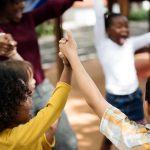By Brianne Roos and Carey Borkoski | Originally published in the Back-to-School 2020 issue of AC&E/Equity & Access
According to Education Week (2020), by the third week of March, more than 55 million US public school students found their schools closed due to the COVID-19 pandemic. US teachers and caregivers pivoted completely to remote learning within a matter of two weeks. State accountability tests were cancelled, standards and competences were adjusted, and leaders, teachers, and parents focused on areas of instruction and content deemed most critical to their students’ learning.
Interestingly enough, educators and parents also recognized the importance of listening to, caring for, and connecting with their students. This included setting up time for teachers to connect directly with students, opportunities for peer-to-peer connections, and virtual spaces for parents to talk with teachers and other parents. During this unprecedented crisis, educators and parents alike agreed that state standards, accountability measures and these more traditional elements of what researchers call the global education reform movement (Sahlberg, 2007) may not be as important as we once believed.
As we reflect on this period of triage and crisis, learn from the adaptations and instructional approaches, and make plans for teaching and learning in the fall, we should pause and seriously consider and identify what is essential, what matters, and what we want our post-pandemic educational system to reflect moving forward.
Time to Reimagine Our Approach to Teaching and Learning
The pandemic and need to physically distance forced educators into a triage and crisis response mode. Consequently, teaching and learning varied wildly, but crisis mode is not tenable, and leaders and teachers soon shifted to contingency planning for the fall. We suggest that the U.S. education leaders, teachers, and families take advantage of this shock to our education system and reimagine our approaches to teaching and learning using an Understanding By Design framework (UBD; Wiggins & McTighe, 2005).
In this approach, stakeholders consider the question of what students need to learn BEFORE assessments, teaching approaches and standards are identified. Arguably, the US system currently operates in the reverse, with standards and tests often driving classroom instruction and school curricula. UBD focuses on identifying the learning goal, fostering connection and making meaning, and the transfer of knowledge.
As we reflect on the spring and plan for the new school year, we have a chance to change structures, systems, and policies by considering student goals beyond assessment outcomes. What if we paused for just a moment and asked ourselves – what do we really want to accomplish with and for our students?
Finland’s collective decision to veer away from global education reform toward a more holistic approach to student development may offer the U.S. some insights. A system that does not emphasize testing and traditional school subjects may be difficult to conceptualize, but Sahlberg (2007) suggested these holistic foci should not be ignored, and that it may be possible to create a system using alternative approaches and policies as demonstrated in Finland.
Goals of Finnish Education
Finnish educators have effectively integrated both the process and outcomes of learning into their curriculum and standards. They attend to and value the way students view school and school-related tasks while also cultivating important student outcomes. This approach to education is anchored in developing students as human beings who recognize their effect on others and the world (Lahedmaki, 2019).
The Finnish learning process includes consistent attention to each student’s place as a citizen of the school, community and world. Students’ experiences, or processes of learning, are of utmost importance. To that end, Finnish education strongly regards relationships and sustainability. Overall, three central themes of Finnish education guide our proposed reimagining of the American education system (Lahdemaki, 2019):
- Rethinking social and emotional learning as integrative not additive
- Cultivating a collective or other-centered school culture
- Identifying ways to effectively mix school subjects to promote articulated goals
Social and Emotional Learning
Finnish educators view learning as a social endeavor. Collaboration is a central emphasis; students learn together and share the joy of discovery. Finland employs project-based learning to facilitate collaboration among students and teacher groups, as projects often span more than one subject area. Teachers model cooperative learning for their students, who then carry out projects that may involve defining and dividing roles, problem solving, and shared decision making.
Social learning contributes to the mission of developing students who understand their role in groups at school, home, and in the community. Rethinking education from a social perspective also includes intentional and ongoing exploration and discussion of feelings, demonstrating an explicit prioritization of social and emotional learning in Finland.
While Finland serves as a model of rethinking social and emotional learning, the concepts are not new to educators in the U.S. Emotional intelligence, or the ability to recognize and understand the emotions and feelings of oneself and others, was established in the American psychological literature by Salovey and Mayer in 1990. However, 30 years later, our schools do not hold students’ social and emotional learning with the same level of regard as academic subject matter.
Brackett (2019) writes about the critical role of social and emotional learning in our schools and describes the process of becoming what he calls emotion scientists. Understanding emotion is not intuitive or innate, it is a process that must be learned, just like we must learn math and history. Students, teachers, and school leaders need to invest in becoming emotion scientists because human emotions affect every interaction and human experience — and not just in times of pandemic or crisis.
Brackett cites numerous studies that demonstrate the deteriorating mental health of our students and teachers before COVID-19, and recent work suggests the urgency of addressing social and emotional learning and health in the context of the pandemic (Cipriano & Brackett, 2020). What better time to rethink social and emotional learning in our schools?
School Culture
Finnish schools are also characterized by an intentional focus on school culture and, in particular, connections between each school and its community (Lahdemaki, 2019). Schools in Finland are not siloed. Rather, administrators and teachers at individual schools have agency to interpret and apply the goals of the national curriculum in ways relevant to diverse communities.
One size does not fit all, and the Finnish system recognizes the essential connections between curricular goals and objectives, the people who implement the curriculum, and their communities. Moreover, teachers view students as partners in learning. This partnership creates students’ sense of agency and ultimately a sense of belonging in their school. Finnish schools reflect the values and diversity of their communities and individuals in these communities.
How can we rethink American education from a school culture and community perspective?
The events following George Floyd’s death implore us to consider our communities deeply and to situate education in the lived experiences of all our students. We have an obligation to teach about and within the system so that educators and students can identify and consider how their position and experiences contribute to the status quo and can also affect change.
If we consider the Finnish model, school culture and community begin with establishing students’ sense of belonging. All students should be valued contributors to their respective schools and communities. Maslow (1943) placed belonging on his seminal hierarchy of needs that is arranged as a pyramid and depicts basic needs (i.e., physiological and safety), psychological needs (i.e., belongingness and love and esteem), and self-fulfillment needs (i.e., self-actualization). Tinto (1975, 2010) described belonging in the context of higher education as students’ needs to meaningfully connect with peers, faculty, campus life, and activities through interpersonal relationships.
Best practices in culturally responsive pedagogy demand that we reimagine our school and community cultures to meet the needs of our students by taking antiracist action and prioritizing the value and worth of each student.
School Subjects
The third theme of Finnish education to consider is rethinking school subjects. Movement away from traditional school subjects toward seven transversal competencies of education characterizes Finland’s unique approach to education. Developing students as human beings and citizens is the central mission of the transversal competencies, which include care for self and others, cultural competence, multi-literacy, technological competence, competence for work and entrepreneurship, sustainability, and thinking and learning to learn.
The competencies demonstrate the value of educating the whole student — someone who will become an active participant in society with abilities to progress and contribute to a sustainable future. Academic subject matter is embedded in the competencies (e.g., literacy, technology) but subject matter expertise is not the ultimate goal of Finnish education. The emphasis is on transferable skills and attributes such as creativity, social and emotional health for oneself and others, and sustainability.
What can we learn from Finland’s emphasis on the process of learning, collaboration, identity development, and holistic education? Interestingly, creativity, people management, coordinating with others, emotional intelligence, and service orientation are among the top ten skills that chief human resource and strategy officers value for employment and recruitment in the Future of Jobs Report by the World Economic Forum (Gray, 2020).
In a 2016 study on Google and what makes teams high performing, researchers found that productivity was not a function of who was on the team — it was a function of how they worked together. The most productive teams cultivated psychological safety and equal time for team members’ contributions to projects. The importance of these “soft skills” to employers, leaders, and managers is reflected in numerous articles over the past year in publications like the New York Times and Harvard Business Review.
Physical distancing mandates due to COVID-19 forced U.S. educators to reprioritize to meet students’ basic physiological and safety needs. Educators mobilized to distribute meals and keep students and staff distant to prevent the spread of the virus. Teachers in kindergarten through higher education pivoted to online learning. Now, as we plan for the fall, we have a rich opportunity to reflect in action (Schon, 1991) to reimagine our values and goals.
Separation has taught us how much we crave connection with fellow educators and our students. Trying to live while processing intense emotions of isolation, fear and moments of joy demonstrates the need for improved social and emotional learning. While our nation is in a period of relative stillness, we consider the racism and injustice that pervade our systems, a glaring and painful reminder that we must rethink our cultures and communities along with our students.
Please join us in reconsidering the essentials of education in the US. Let’s reimagine a system that educates the whole student and prepares them to be valued and active contributors to local, national, and global communities.
Dr. Brianne Roos is an Assistant Professor and director of the undergraduate program in the Department of Speech-Language-Hearing Sciences at Loyola University Maryland. Her career began as a clinician practicing medical speech-language pathology in hospital settings, where her favorite days were spent teaching and supervising students and new clinicians. She has been teaching in higher education for over 15 years and her areas of research include belonging, stress, well-being, and connection for students and faculty. Brianne facilitates workshops about teaching and learning for faculty across disciplines and she particularly enjoys the opportunity to develop and implement holistic onboarding programming to support new faculty. Brianne co-hosts a podcast about belonging, where she learns from a diverse range of guests and whose data contribute to research about belonging during the pandemic, in leadership, and in relationships. Always looking for alignment across established high-impact practices and innovative, engaged pedagogy, Brianne’s publications, presentations, podcasts, and classroom practices connect theoretical support with application that centers the whole person.
Dr. Carey Borkoski is an Associate Professor at Johns Hopkins University where she holds a joint faculty appointment with the School of Education and the Bloomberg School of Public Health. Within the School of Education, she teaches research methods and advises doctoral students in the online EdD program. Her research explores the role of communities, bridging media like podcasts and TedTalks, and storytelling in facilitating student onboarding, promoting deeper learning, and mitigating anxiety around learning and engaging in often unfamiliar academic spaces. Connect with her at momentmcoaching.com
-
Dr. Carey Borkoskihttps://ace-ed.org/author/cborkoski/July 7, 2024
-
Dr. Carey Borkoskihttps://ace-ed.org/author/cborkoski/
-
Dr. Carey Borkoskihttps://ace-ed.org/author/cborkoski/February 27, 2023
-
Dr. Carey Borkoskihttps://ace-ed.org/author/cborkoski/November 18, 2022








